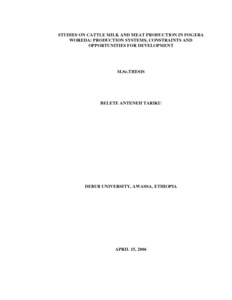Resource information
The study was conducted in Fogera woreda which is one of the districts found in Northwestern of the Amharan region with the aim of Characterization of cattle milk and meat production systems of the woreda, to provide the basis for cattle development interventions. Even though the known indigenous Fogera breed is also found in this woreda little attention has been given to characterize the milk and meat production systems, to assess the production inputs, to identify the dairy products and beef market chain participants and to identify the main constraints and outline the interventions, it is due to this understanding that the present study was initiated. Twelve sample peasant associations were randomly selected (five from Fogera plain and seven outside of the plain) based on the potentiality of milk and meat production. 480 respondents participated of the study. Different survey techniques; namely focus group discussion, data collection by developing formats, personal observations and administration of semi-structured questionnaires on milk and meat production practices were employed. Findings of focus group discussions revealed that the types of cattle husbandry practices of the respective study sites (PAs) were different between rural and urban areas. Findings from the semi-structured interviews revealed that 98.75 % of cattle milk and meat productions were undertaken by indigenous cattle breeds. The type of husbandry practice was traditional. Furthermore, the respondents were very much interested to improve their local breeds by artificial insemination and natural mating by crossbred bulls to upgrade the milk productivity of the breeds. The number of cattle per household was significantly different among the village (P< 0001). And also the average number of milking cows per household ranges from 1.18 to 2.08. The holding of milking cows per household was 1.59 + 0.04 where as holding of private pastureland was 0.18 + 0.09, thus the lower production of milk per household may be due to insufficient pasturelands and feed scarcity. Milk produced per household was highly correlated (P<0.01) with the number of cows owned by the household and less correlated (P<0.05) with area of pasture owned by the household. The average lactation length for local breeds was 7.5 months and the average daily milk yield was 1.5 liters. Age at first calving was 3-5 years and perhaps due to malnutrition. The reported critical constraints of traditional cattle production were seasonal feed shortage, high disease prevalence challenges, lack of crossbreeds, lack of working capital and lower demand for dairy and beef products due to long fasting periods and lower purchasing power of the consumers.


